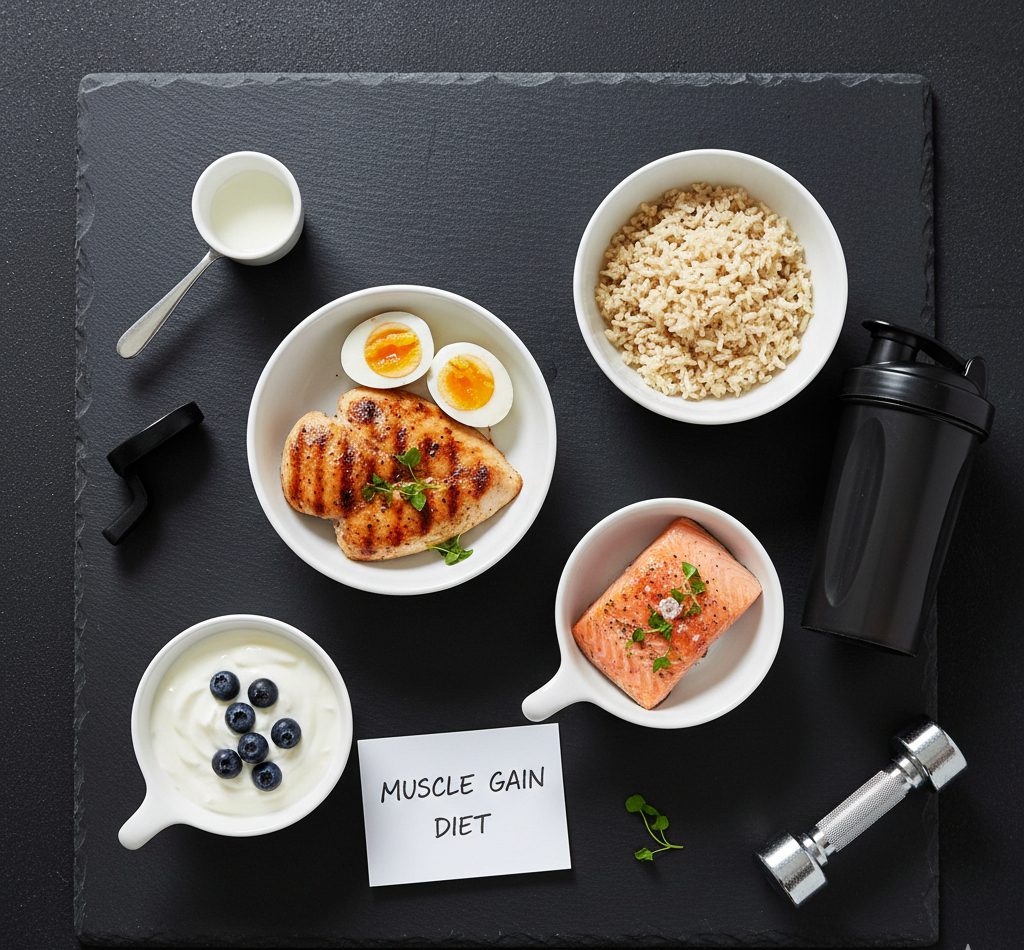A practical, evidence-based guide to protein targets, meal timing, a 7-day muscle-gain plan, grocery list, and smart supplements—optimized for steady lean mass growth.
Introduction: Protein Is the Foundation of Muscle Growth
Every set you complete creates microscopic muscle damage that must be rebuilt stronger. Protein supplies the amino acids for that repair. Many lifters either under-eat total protein or mistime it. A high-protein plan closes that gap—boosting recovery, metabolism, and lean gains with minimal fat.
Start by finding your target with the NutriFitCalc Protein Calculator.
Understanding Protein: The Science Behind Muscle Gain
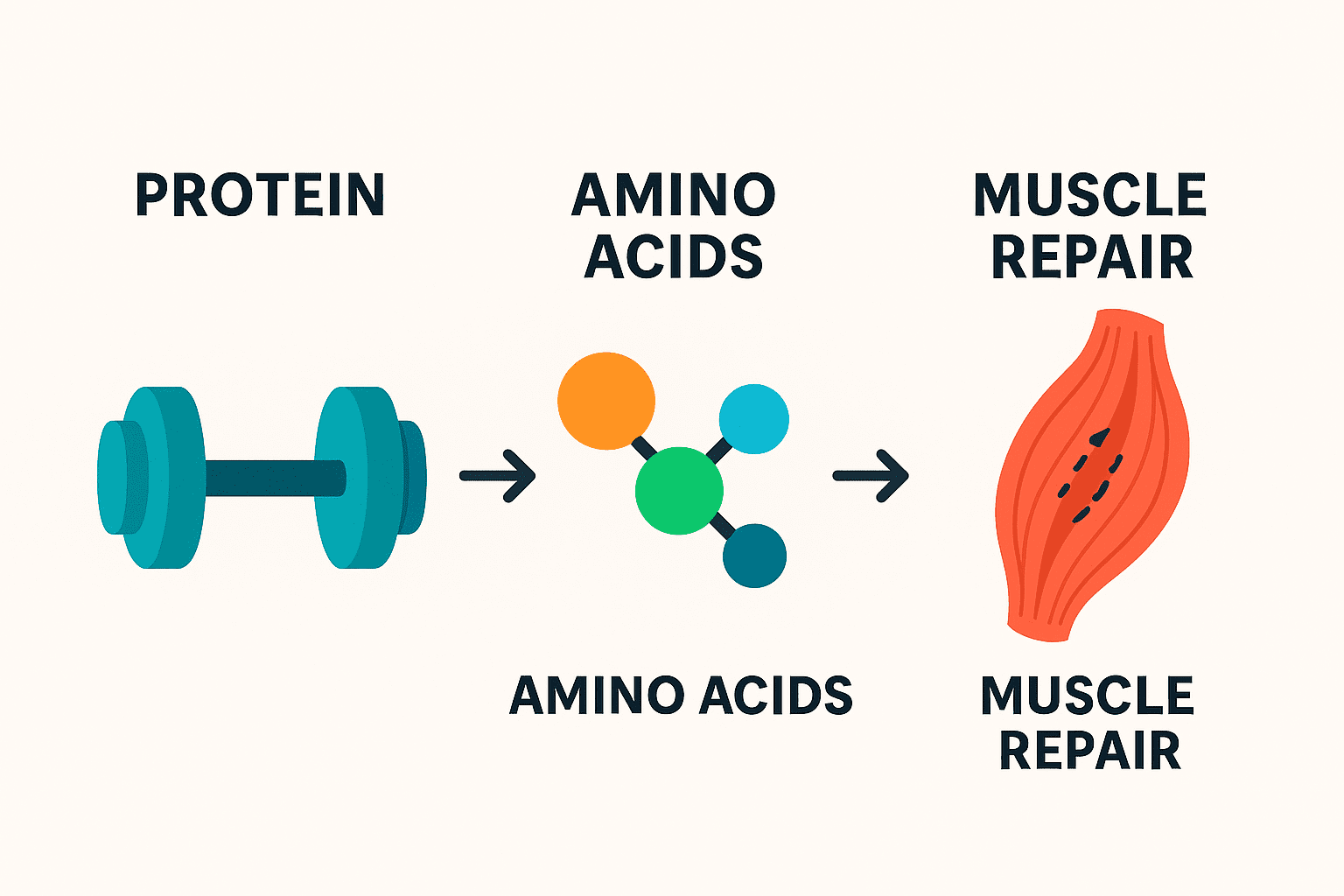
- Supports muscle recovery and repair
- Increases metabolic rate
- Improves appetite control
- Helps retain lean mass during cuts
How Much Protein Do You Need?
Many active people seeking muscle gain do well with about 1.6–2.2 g/kg body weight/day. Example: a 70 kg lifter targets 112–154 g/day.
Balance your macros with the Calories Calculator and track status with the BMI Calculator.
Muscle-Gain Macros & Calories
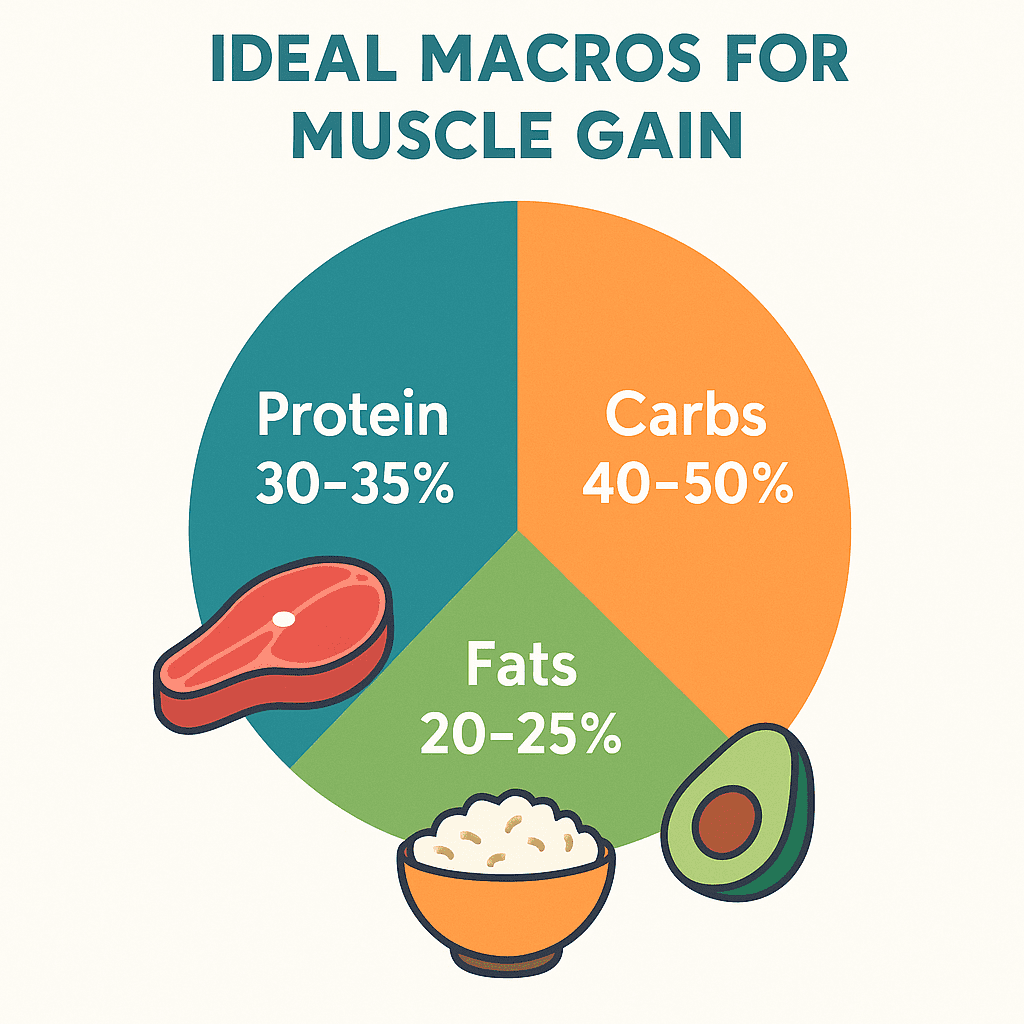
| Nutrient | Target % of Calories | Primary Purpose |
|---|---|---|
| Protein | 30–35% | Muscle repair & growth |
| Carbohydrates | 40–50% | Training fuel & recovery |
| Healthy fats | 20–25% | Hormones & joints |
Calorie target: aim for a modest surplus of about +10–15% above maintenance to add lean mass without excess fat.
When to Eat Protein: Timing Matters
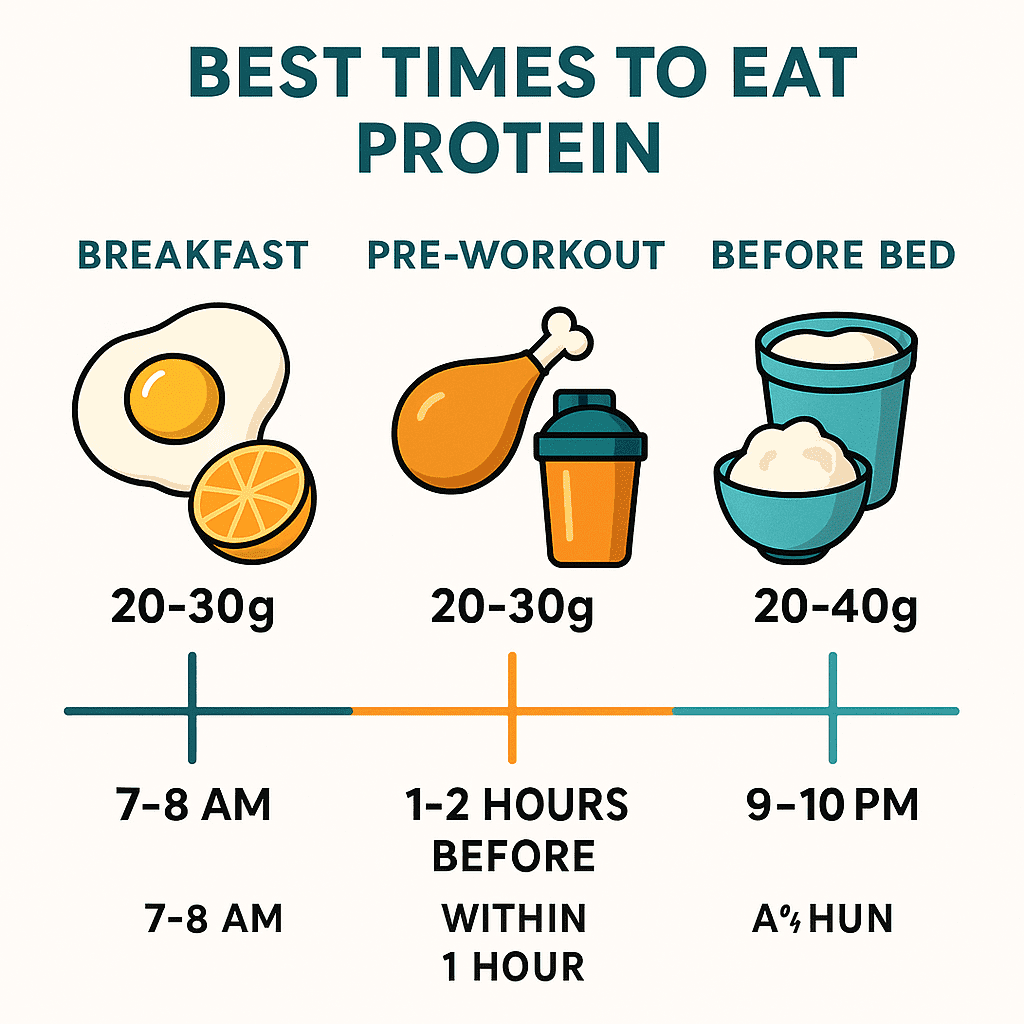
- Breakfast: Break the overnight fast with ~30 g (eggs, Greek yogurt, whey) + complex carbs (oats, whole-grain toast).
- Pre-workout (1–2 h): ~25–30 g protein + moderate carbs (banana, brown rice).
- Post-workout (≤45 min): 30–40 g fast-digesting protein (whey, lean meat) + simple carbs for glycogen.
- Before bed: Slow protein (casein, cottage cheese, Greek yogurt) to reduce overnight breakdown.
7-Day High-Protein Meal Plan for Muscle Gain
Adjust portions with Calories Calculator and targets from the Protein Calculator.
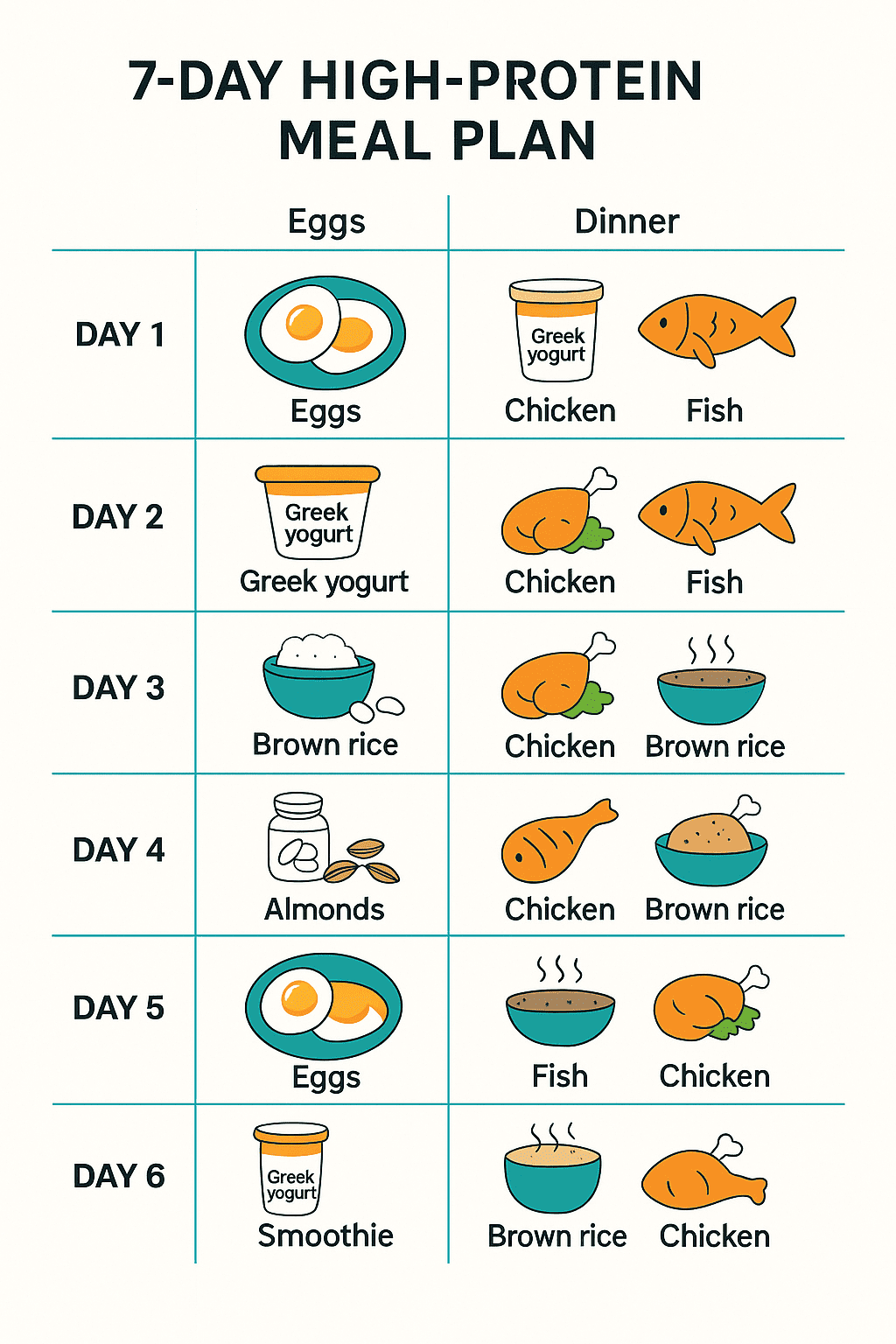
Day 1
- Breakfast: Oats + berries; 4 egg whites + 2 whole eggs
- Snack: Whey shake + almonds
- Lunch: Grilled chicken breast, quinoa, steamed broccoli
- Snack: Greek yogurt + honey
- Dinner: Baked salmon, sweet potato, asparagus
- Pre-bed: Cottage cheese + chia seeds
Day 2
- Breakfast: Protein pancakes + banana
- Snack: Boiled eggs + apple
- Lunch: Turkey wrap (whole-grain) + veggies
- Snack: Rice cakes + peanut butter
- Dinner: Lean-beef stir-fry with brown rice
- Pre-bed: Casein shake
Day 3
- Breakfast: Greek yogurt, blueberries, granola
- Snack: Walnuts
- Lunch: Tuna salad (olive oil, spinach)
- Snack: Protein bar or boiled eggs
- Dinner: Chicken breast, sweet corn, brown rice
- Pre-bed: Milk + almonds
Day 4
- Breakfast: Protein oats + banana slices
- Snack: Cottage cheese + pineapple
- Lunch: Grilled fish tacos + avocado salsa
- Snack: Mixed nuts + yogurt
- Dinner: Turkey chili with beans & peppers
- Pre-bed: Peanut-butter toast + milk
Day 5
- Breakfast: Scrambled eggs, spinach, whole-grain toast
- Snack: Banana + whey
- Lunch: Chicken & broccoli rice bowl
- Snack: Low-fat cheese sticks + apple
- Dinner: Shrimp stir-fry with vegetables
- Pre-bed: Greek yogurt + chia
Day 6
- Breakfast: Smoothie (banana, protein powder, almond butter)
- Snack: Boiled eggs + almonds
- Lunch: Tuna wrap (whole-grain)
- Snack: Carrots + hummus
- Dinner: Grilled steak, quinoa, green beans
- Pre-bed: Cottage cheese + honey
Day 7
- Breakfast: Protein oats + blueberries
- Snack: Greek yogurt + nuts
- Lunch: Chicken Caesar salad (light dressing)
- Snack: Whey + banana
- Dinner: Grilled fish + roasted vegetables (olive oil)
- Pre-bed: Milk + almonds
Grocery List (High-Protein Focus)
- Proteins: Chicken breast (6–8), lean beef (~500 g), salmon/tilapia (3 fillets), canned tuna, eggs (≥12), Greek yogurt (2 tubs), cottage cheese (~1 kg), whey protein, casein (optional)
- Carbs: Brown rice (1 kg), quinoa (≈500 g), oats (≈500 g), sweet potatoes (4–5), whole-grain bread/wraps, fruit (bananas, apples, berries)
- Fats & extras: Olive oil, avocados, nuts, peanut butter, chia & flax seeds, almond or low-fat milk, herbs/spices, salt & pepper
Pro tip: Batch-cook twice weekly so proteins stay fresh.
Sample Macro Setup
Example: 75 kg male, strength training
- Maintenance ≈ 2,400 kcal → Gain target: 2,650–2,750 kcal (+10–15%)
- Protein: 150–165 g/day
- Carbs: 300–320 g/day
- Fats: 60–70 g/day
Choose Quality Proteins
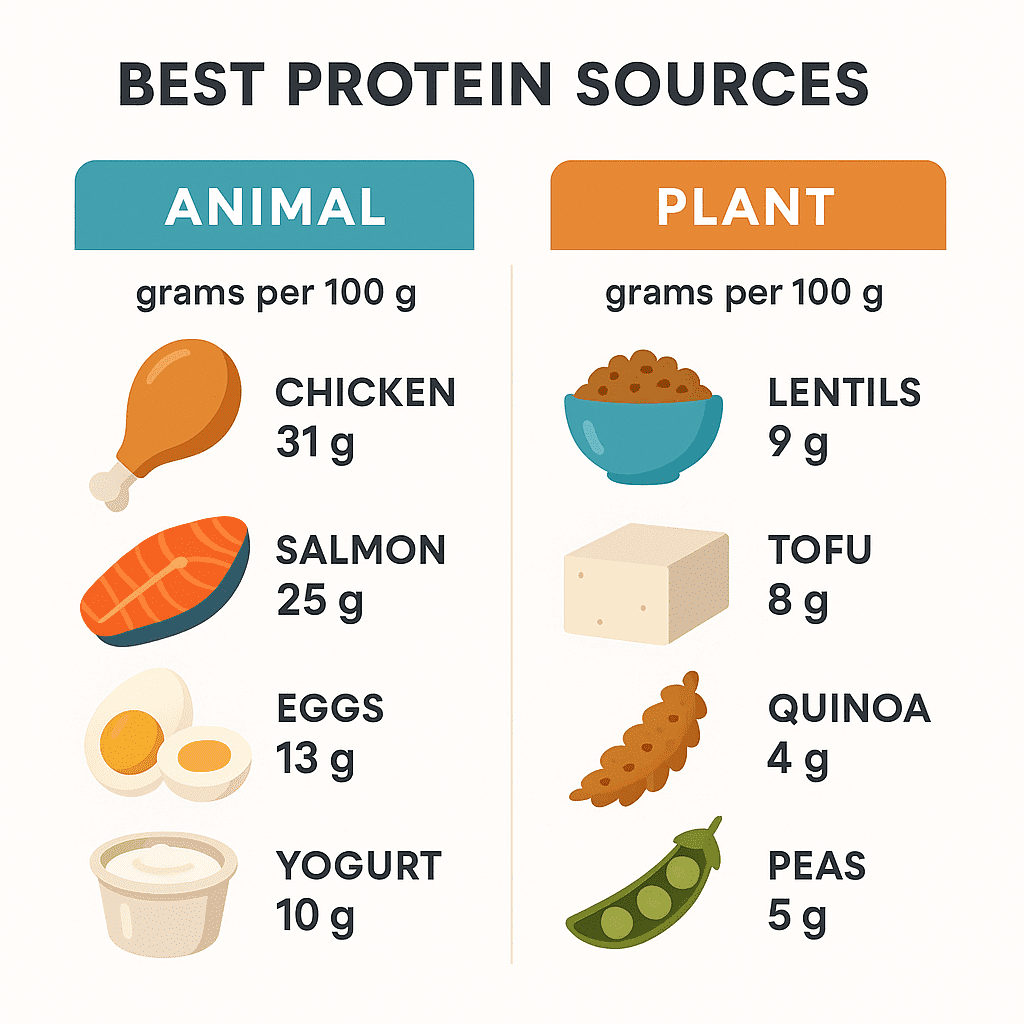
Animal sources
- Chicken breast
- Fish (salmon, tuna)
- Lean beef
- Eggs
- Dairy (yogurt, milk, cheese)
Plant sources
- Lentils, chickpeas
- Tofu, tempeh
- Quinoa
- Peas & beans
Mix animal and plant proteins for a complete amino acid profile and better digestion.
Common Mistakes to Avoid
- Skipping the calorie surplus—too little food stalls growth
- Overusing shakes instead of whole foods
- Skipping breakfast or post-workout meals
- Under-fueling carbs for hard training
- Inconsistent meal timing
Helpful Supplements (Optional)
| Supplement | Benefit | Typical Dose |
|---|---|---|
| Whey protein | Fast post-workout recovery | 25–30 g |
| Creatine monohydrate | Strength & muscle gain | 3–5 g/day |
| Omega-3 fish oil | Inflammation support | 1–2 g/day |
| Multivitamin | Micronutrient coverage | Daily with food |
| BCAAs | Optional for fasted training | 5–10 g |
Training & Lifestyle Tips
- Lift 4–5 days/week with progressive overload
- Sleep 7–8 hours/night
- Hydrate: ~3 L/day
- Limit alcohol—it disrupts protein synthesis
- Track output with the Calories Calculator
Strength training + high-protein nutrition commonly adds ~1–2 kg lean mass per month (individual results vary).
Example Daily Schedule
| Time | Meal | Example |
|---|---|---|
| 7:00 am | Breakfast | Scrambled eggs + oatmeal |
| 10:00 am | Snack 1 | Whey + almonds |
| 1:00 pm | Lunch | Chicken bowl + rice |
| 4:00 pm | Snack 2 | Greek yogurt + fruit |
| 6:00 pm | Workout | Strength training |
| 7:00 pm | Post-workout | Protein shake + banana |
| 9:00 pm | Dinner | Salmon + vegetables |
| 11:00 pm | Pre-bed | Cottage cheese |
Track Your Muscle-Gain Journey
- Reassess every 2 weeks: body measurements, progress photos
- Log strength (sets × reps × load); aim for gradual increases
- Use NutriFitCalc tools to tweak macros; if stalled, add +200–300 kcal/day (mostly carbs + protein)
FAQs
How soon will I see results?
With consistent training and nutrition, many notice visible changes in 3–6 weeks.
Is “high protein” safe?
Intakes up to ~2.2–2.5 g/kg are commonly used by healthy lifters; stay hydrated and follow medical guidance if you have conditions.
Pre vs post-workout protein?
Both help—pre fuels performance, post supports recovery. Distribute protein across 4–5 feedings.
Can I build muscle without meat?
Yes—combine plant proteins (soy, lentils, beans, quinoa) to hit your daily target.
Best nighttime protein?
Casein or cottage cheese—slow-digesting for overnight recovery.
Final Thoughts: Train Hard, Eat Smart, Recover Right
There are no shortcuts—just consistent habits. Use Protein Calculator, Calories Calculator, and BMR Calculator to personalize intake, track progress, and unlock your natural potential.
About the Author
This article is written by the NutriFitCalc Team, a group of Food Science and Nutrition students who create simple, research-backed guides for healthy living.
We review global health sources like WHO and CDC to keep our content accurate and helpful.
